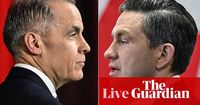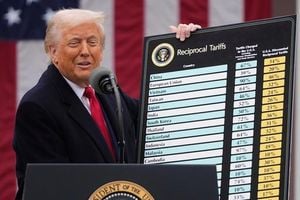Canadians are heading to the polls on April 28, 2025, in a federal election overshadowed by escalating tensions with U.S. President Donald Trump, whose recent comments have sparked national outrage regarding Canada’s sovereignty. This election has been described by all party leaders as possibly the most consequential in a lifetime, with a month-long campaign that has seen dramatic shifts in voter sentiment.
As the election date approaches, opinion polls suggest a tight race between the Liberal Party, led by Mark Carney, and the Conservative Party, headed by Pierre Poilievre. Recent surveys indicate that the Liberals hold a slight lead, with an estimated popular vote share of 41 percent, just two points ahead of the Conservatives, according to Abacus Data’s final likely-voter election model. This is a significant narrowing from a five-point lead reported earlier in April.
The dominant issue throughout the campaign has been which candidate can best protect Canada against aggressive trade actions from Trump. Voters appear to favor Carney on this front, positioning him as a strong defender of Canadian interests. Poilievre has emphasized the need for a change in direction after nearly a decade of Liberal governance, focusing on pressing issues such as the cost of living, housing, and deficit control.
In the final days of campaigning, both leaders crisscrossed the country, holding rallies and engaging with voters. Carney, who is running in his first election campaign after replacing Justin Trudeau in March, made several stops in the Toronto region, culminating in a rally that attracted thousands. He also traveled to the western provinces of Saskatchewan, Alberta, and British Columbia to shore up support in urban areas.
However, the campaign was marred by tragedy when a car ramming incident at a street festival in Vancouver resulted in the deaths of 11 people and injuries to dozens more. This event prompted Carney to adjust his travel plans to address the nation and meet with community leaders affected by the tragedy.
The Liberal Party is expected to benefit from Canada’s first-past-the-post electoral system, which often allows them to secure more seats despite having a wider but less concentrated voter base. In contrast, while the Conservatives enjoy significant support in regions like Alberta and Saskatchewan, this concentration can lead to what some describe as "wasted votes" that fail to translate into additional parliamentary seats.
Polls indicate that the Liberals maintain a strong position in Quebec, holding 23 percent of the seats in the House of Commons, and have a smaller lead in Ontario, which accounts for about 36 percent of the seats. British Columbia appears to be a battleground, with support for both parties nearly evenly split.
Carney’s rise in the polls can be attributed in part to the changing political landscape influenced by Trump’s interventions. The U.S. president has made headlines with provocative statements about Canada potentially becoming the 51st U.S. state, igniting a wave of nationalistic sentiment among Canadian voters. "It’s about our sovereignty and our identity," said Raj Patel, a small business owner in Vancouver, reflecting the concerns many Canadians feel about their relationship with the U.S.
In response to Trump’s comments, Poilievre has taken a firm stance, asserting on social media, "President Trump, stay out of our election. The only people who will decide the future of Canada are Canadians at the ballot box." His remarks underscore the Conservative leader’s attempt to distance himself from Trump’s controversial statements while still appealing to voters who may feel marginalized by political elites.
Despite the close race, the NDP, led by Jagmeet Singh, is facing a significant decline in support, with projections suggesting a potential wipeout in seat count. Singh’s party had previously secured some policy victories through a deal to prop up the Liberal government, but he has struggled to convert that into electoral gains for his own party.
As the election approaches, a record number of Canadians—7.3 million—have already cast their ballots during the early voting period, surpassing the 5.8 million who voted early in the previous election. This surge in voter participation reflects the heightened stakes of this election and the intense interest among Canadians in shaping their political future.
In summary, as Canadians prepare to cast their votes, the election remains a complex interplay of regional dynamics, national concerns about sovereignty, and the shifting political landscape influenced by external factors. The outcome will not only determine the next prime minister but also set the course for Canada’s future amid growing geopolitical tensions.





